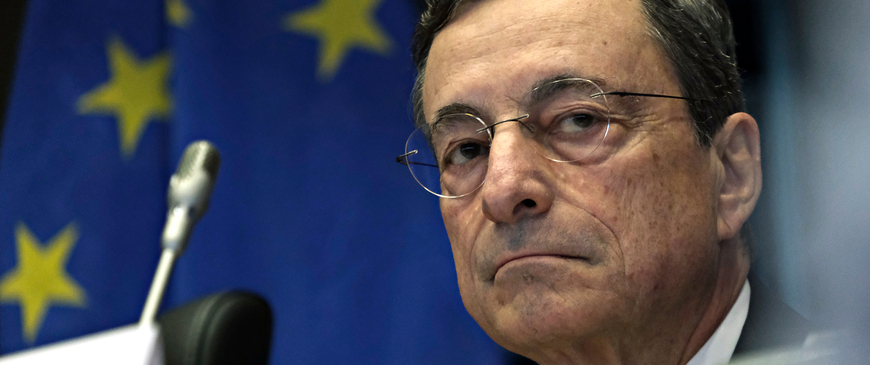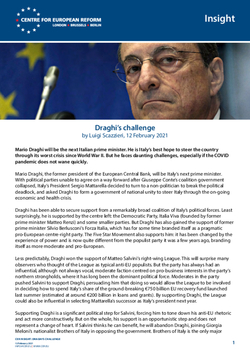
Draghi's challenge
Mario Draghi will be the next Italian prime minister. He is Italy’s best hope to steer the country through its worst crisis since World War II. But he faces daunting challenges, especially if the COVID pandemic does not wane quickly.
Mario Draghi, the former president of the European Central Bank, will be Italy’s next prime minister. With political parties unable to agree on a way forward after Giuseppe Conte’s coalition government collapsed, Italy’s President Sergio Mattarella decided to turn to a non-politician to break the political deadlock, and asked Draghi to form a government of national unity to steer Italy through the on-going economic and health crisis.
Draghi has been able to secure support from a remarkably broad coalition of Italy’s political forces. Least surprisingly, he is supported by the centre left: the Democratic Party, Italia Viva (founded by former prime minister Matteo Renzi) and some smaller parties. But Draghi has also gained the support of former prime minister Silvio Berlusconi’s Forza Italia, which has for some time branded itself as a pragmatic pro-European centre-right party. The Five Star Movement also supports him: it has been changed by the experience of power and is now quite different from the populist party it was a few years ago, branding itself as more moderate and pro-European.
Draghi has been able to secure support from a remarkably broad coalition of Italy’s political forces.
Less predictably, Draghi won the support of Matteo Salvini’s right-wing League. This will surprise many observers who thought of the League as typical anti-EU populists. But the party has always had an influential, although not always vocal, moderate faction centred on pro-business interests in the party's northern strongholds, where it has long been the dominant political force. Moderates in the party pushed Salvini to support Draghi, persuading him that doing so would allow the League to be involved in deciding how to spend Italy’s share of the ground-breaking €750 billion EU recovery fund launched last summer (estimated at around €200 billion in loans and grants). By supporting Draghi, the League could also be influential in selecting Mattarella’s successor as Italy’s president next year.
Supporting Draghi is a significant political step for Salvini, forcing him to tone down his anti-EU rhetoric and act more constructively. But on the whole, his support is an opportunistic step and does not represent a change of heart. If Salvini thinks he can benefit, he will abandon Draghi, joining Giorgia Meloni’s nationalist Brothers of Italy in opposing the government. Brothers of Italy is the only major political force that has refused to support Draghi. Indeed, Salvini will be worried that Meloni, being the only opposition, will overshadow him as leader of the right if Draghi disappoints.
Supporting Draghi is a significant political step for Salvini, forcing him to tone down his anti-EU rhetoric.
With Draghi in power, Italy will be led by a heavyweight. He is a highly respected figure thanks to his crucial role and political skill in rescuing the eurozone from its dual sovereign debt and banking crises. Draghi’s competence and standing will, at least in the near term, reassure bond traders eyeing Italy’s large debt stock: since he has been asked to form a government, interest rates on Italy’s government debt have already fallen. Draghi will also boost Italy’s international profile, in the EU and globally, giving added heft to the country’s G20 presidency and to COP26, which Italy is co-hosting with the UK.
Draghi’s economic expertise means he will be influential in shaping EU discussions about the bloc’s economic recovery. He will try to steer European economic policy away from a premature and damaging return to fiscal austerity, and towards sufficient stimulus so that economies can fully recover, in order to prevent deepening divergence within and between European countries. The fact that Draghi is Italy’s prime minister will make it easier for the European Commission to apply Europe’s fiscal rules liberally in the coming years. And should the pandemic drag on or create further economic damage, Draghi is well-placed to contribute to the discussion on topping up the EU recovery fund.
Draghi’s economic expertise means he will be influential in shaping EU discussions about the bloc’s economic recovery.
In some ways, Draghi’s task is easier than that of some of his predecessors, especially fellow technocrat Mario Monti, who served as prime minister at the peak of Italy’s debt crisis between 2011 and 2013. Whereas Monti had to find ways to cut public spending and seek additional revenue, Draghi’s immediate task will be spending the money from the EU recovery fund. This means that, at least in the immediate term, Draghi is unlikely to become as unpopular as Monti was. His main challenge will be spending the money from the fund in a way that generates a strong economic recovery and increases Italy’s growth potential in the medium term.
But spending the funds is not enough. The European Commission expects the spending to go hand-in-hand with reform. Draghi will find it just as challenging to enact long called-for reforms to strengthen Italy’s economy – such as reforming the civil service and the justice system – as did his reform-minded predecessors. The fact that his government depends on such a disparate group of political parties for support will probably restrict his room for manoeuvre and make it difficult for a consensus to emerge. Moreover, it remains to be seen for how long Draghi will be prime minister. In theory he could remain in power until the next election in 2023, but he may not want to serve that long and in any case he will only remain prime minister for as long as his coalition holds together.
More broadly, it is difficult to overstate the scale of the challenges that Draghi and Italy face. The Italian economy shrunk by around 9 per cent in 2020 and Italy’s public debt has now reached 159 per cent of GDP. Unemployment, a lagging indicator, is set to rise, fuelling social discontent. Any social strife would put pressure on the Five Star Movement and the League to withdraw their backing from Draghi.
It is difficult to overstate the scale of the challenges that Draghi and Italy face.
And the situation would worsen if COVID restrictions have to be kept in place beyond this summer. Italy’s current vaccination campaign is progressing slowly. Together with all other EU member-states, the country is simply not receiving enough doses from manufacturers, as a result of the European Commission’s mismanaged procurement and production delays. In a worst-case scenario where the rate of vaccinations stays at the current level, less than a third of all adults in the EU would be vaccinated by September 2021, far off the EU’s target of 70 per cent.
Even if the speed of the vaccination campaign increases substantially in the next few months, it will be very challenging to vaccinate most of Italy's population by the end of the summer. Citizens will blame Draghi and the EU if the rollout of vaccines is delayed. This will be particularly true if other countries like the US, the UK and Israel have managed to complete their vaccination programmes by then, making Italy and the EU look incompetent. And if vaccine-resistant COVID variants spread, forcing Italy to maintain restrictions for longer, the damage to Italy's economy, to its finances and to its social fabric could be severe.
Draghi offers the best hope of uniting the country and providing the leadership needed to steer it through its worst crisis since becoming a republic after World War II. The key challenges that Draghi confronts are not unique to Italy – the EU faces them too. The decision to set up the recovery fund this summer was a very important step, but a bigger package may be needed to ensure that the continent’s economic revival is rapid and just.
Europe’s leaders must also speed the vaccination of Europe’s citizens, and rapidly increase production capacity for the follow-up vaccines that will be needed to deal with any COVID mutations. If Europe’s leaders – and Draghi – fail, voters won’t be kind to them.
Luigi Scazzieri is a research fellow at the Centre for European Reform.


Add new comment